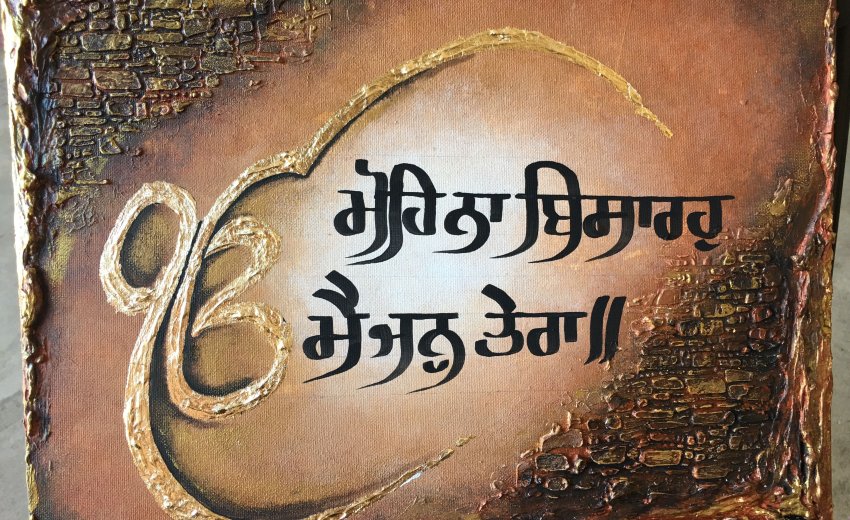In Amritsar, the artist Hardeep Singh has skillfully drafted Gurbani in calligraphy, a beautiful form of writing. This unique endeavour began nearly a year ago, sparked by Hardeep's realization that no one had previously attempted this. The response to his work has been remarkable, as he seeks to bring the elegance of calligraphy to this sacred script. Calligraphy, often associated with its origins in England, now finds a new home in Amritsar through Hardeep Singh's pioneering efforts.
Surindra Singh, a passionate art antique collector, supports his son in his new venture. They have safeguarded priceless art pieces, which ideally fall under the government's responsibility for preservation. In addition, they possess various illustrated materials and are willing to offer them to the government if required.
About the artist
Hardeep Singh, a computer teacher by profession and an artist at heart, skillfully combines technology and tradition in his work. He employs his computer to print page borders and then lovingly transcribes the verses of Gurbani with his hands.
This talented artist's fascination with colours, nurtured since childhood, led him to pursue the calligraphy style of rewriting the sacred Gurbani from the Guru Granth Sahib. Hardeep Singh, a holder of an MCA degree, seamlesslycobines his technological expertise with his artistic sensibilities, creating beautifully illustrated Gurbani. His innate connection with colours, stemming from his passion for painting, sets his work apart by allowing him to craft exquisite colour combinations for the pages.
Hardeep, the great-grandson of Bhai Gian Singh Naqqash, is diligently preserving the priceless artwork created by his father, grandfather, and great-grandfather within the sanctum sanctorum above Har ki Pauri in the Golden Temple. He's now converting these artistic treasures into digital format and has established a family website that showcases their significant contributions to the world of art.
Colours at work
Detailing his style of work, Hardeep says, “I have been using handmade paper for writing scripts. We design borders on computers and print them on sheets. Later, colours are filled in the borders.”
After applying the colours, Hardeep writes the text with a pencil before calligraphing the letters using a special pen. This practice represents an earlier artistic style, distinct from typeset methods. In an endeavour rooted in his family's devotion to art and religion, Hardeep Singh passionately dedicates himself to the calligraphy of the Guru Granth Sahib.
Hardeep employs acrylic colours for this work. Notably, the golden hue is derived from 24-karat gold sheets that are ground into a fine powder. This powder is then mixed with gum to ensure it adheres securely to the paper. To inscribe the text, Hardeep relies on indelible ink, known for its resistance to fading.
The sheets bearing the Gurbani script feature beautifully intricate borders with harmonious colour combinations. Hardeep has used various colours, including golden, purple, green, and brown for the borders while opting for black, brown, red, and green for the text itself.
“I want to write the entire Guru Granth Sahib. Along with that, I also want to draft the Hindi version of Guru Granth Sahib and other slokas of Hindi manuscripts,” Hardeep said. The Guru Granth Sahib will require at least 1,400 sheets, he says.
Admirers all over
Examples of calligraphed Gurbani created by Hardeep are being exhibited worldwide. People from the Sikh community residing abroad, who are familiar with this art form, have taken some of his works to various countries, including the USA, Canada, the UK, England, and different regions of India.
Hardeep recalled a memorable visit from a Japanese professor who taught Punjabi at a university in Japan. The professor was so impressed with Hardeep's work that he took two sheets with him for display purposes.
When asked about the cost of each sheet, Hardeep responded with a smile, stating that it is truly priceless. He and his team do not set a fixed price; instead, they leave it to the discretion of the person who wishes to acquire a piece. The process of creating each sheet is a meticulous one, requiring 3-4 days of dedicated effort. Hardeep emphasized the need for intense concentration to create the borders, add colours, and execute the calligraphy. Any single mistake and the entire sheet has to be discarded. Depending on the preference of the recipient, Hardeep either covers the sheets in plastic or frames them.
Hardeep's family made a heartfelt request to fellow devout Sikhs to adorn their homes with beautifully framed verses of Gurbani. Instead of traditional pictures, they suggest displaying Gurbani in frames, an engaging and spiritually uplifting decor choice. Additionally, it is proposed that organizations such as the Shiromani Gurdwara Prabhandhak Committee (SGPC) take proactive steps to promote the art of Gurbani calligraphy and permit the printing of these meticulously calligraphed birs (holy book), fostering a deeper connection to the divine teachings.
*Based on an article published in DNA India on 13th November 2013
